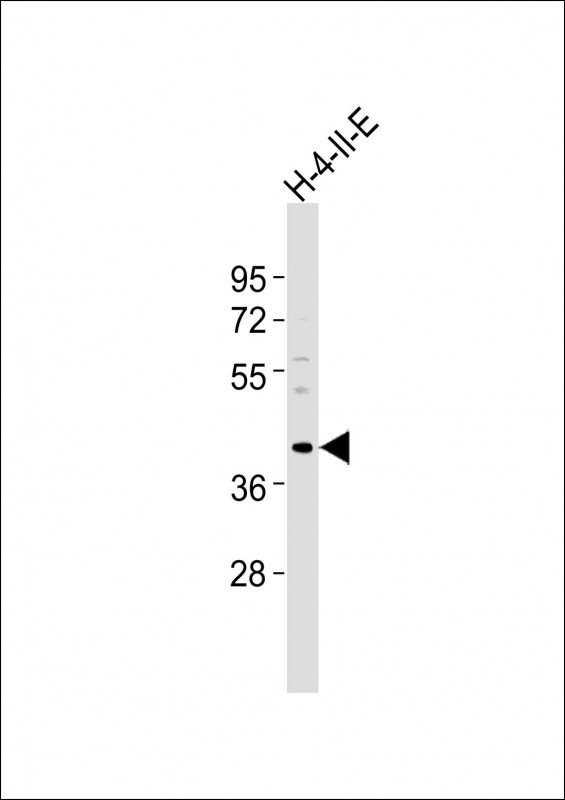
| WB | 1/2000 | Human,Mouse,Rat |
| IF | 咨询技术 | Human,Mouse,Rat |
| IHC | 咨询技术 | Human,Mouse,Rat |
| ICC | 技术咨询 | Human,Mouse,Rat |
| FCM | 咨询技术 | Human,Mouse,Rat |
| Elisa | 咨询技术 | Human,Mouse,Rat |
| Aliases | Polycomb complex protein BMI-1, Polycomb group RING finger protein 4, Bmi1, Bmi-1, Pcgf4 |
| Entrez GeneID | 12151 |
| WB Predicted band size | 36.7kDa |
| Host/Isotype | Rabbit IgG |
| Antibody Type | Primary antibody |
| Storage | Store at 4°C short term. Aliquot and store at -20°C long term. Avoid freeze/thaw cycles. |
| Species Reactivity | Human, Mouse, Rat |
| Immunogen | This mouse Bmi1 antibody is generated from a rabbit immunized with a KLH conjugated synthetic peptide between 235-268 amino acids from the C-terminal region of mouse Bmi1. |
+ +
以下是3篇与Bmi1抗体相关的参考文献概览:
---
1. **文献名称**:*Bmi1 is required for maintenance of adult self-renewing haematopoietic stem cells*
**作者**:Park, I.K., et al.
**摘要**:本研究通过Western blot和免疫荧光技术,利用Bmi1特异性抗体证实Bmi1在造血干细胞自我更新中的关键作用。抗体检测显示Bmi1缺失导致干细胞分化能力丧失。
2. **文献名称**:*The Polycomb group protein Bmi1 is a marker for proliferating neuroblasts in the mammalian brain*
**作者**:Molofsky, A.V., et al.
**摘要**:通过免疫组化(Bmi1抗体染色)揭示Bmi1在成年小鼠脑部神经前体细胞中的表达模式,表明其通过调控细胞周期蛋白参与神经干细胞的增殖维持。
3. **文献名称**:*Bmi1 is essential for cerebellar development and is overexpressed in human medulloblastomas*
**作者**:Leung, C., et al.
**摘要**:利用Bmi1抗体进行组织染色和蛋白质分析,发现Bmi1在小脑发育中不可或缺,且其在髓母细胞瘤中高表达,提示其作为癌症治疗靶点的潜力。
---
以上研究均通过特定Bmi1抗体进行蛋白定位或定量分析,支撑了Bmi1在干细胞及癌症中的功能结论。
The Bmi1 (B-cell-specific Moloney murine leukemia virus integration site 1) protein, a member of the Polycomb repressive complex 1 (PRC1), plays a critical role in epigenetic regulation by maintaining transcriptional repression of target genes. It is essential for sustaining self-renewal in stem cells and is implicated in oncogenesis, where its overexpression is linked to various cancers, including gliomas, leukemias, and solid tumors. Bmi1 functions through chromatin modification, notably by catalyzing histone H2A ubiquitination, which facilitates gene silencing and influences cellular processes like proliferation, senescence, and DNA damage response. Its activity is closely associated with the suppression of p16INK4a and p19ARF tumor suppressor pathways.
Mouse Bmi1 antibodies are widely used to detect and study endogenous Bmi1 protein in murine models, enabling research into developmental biology, stem cell dynamics, and cancer mechanisms. These antibodies are validated for techniques such as Western blotting, immunohistochemistry (IHC), and immunofluorescence (IF), often tested in Bmi1-knockout controls to confirm specificity. Host species (e.g., rabbit, mouse) and clonality (monoclonal/polyclonal) vary, allowing flexibility across experimental designs. Reliable detection of Bmi1 in tissues or cell lysates aids in exploring its role in maintaining stemness, tumor progression, and potential therapeutic targeting.
Understanding Bmi1's regulatory network through such antibodies provides insights into aging, differentiation, and malignancy, highlighting its dual role as a guardian of stem cell function and a driver of oncogenic transformation.
×